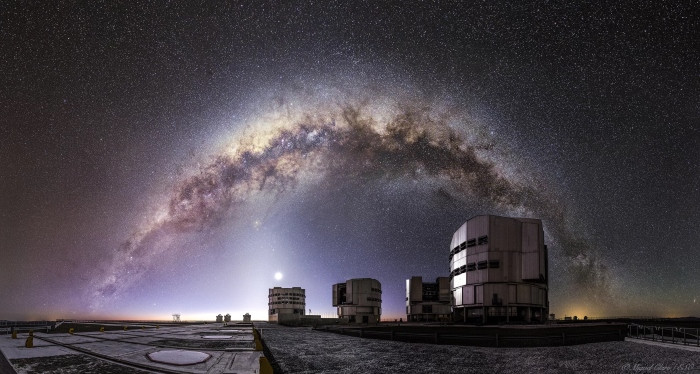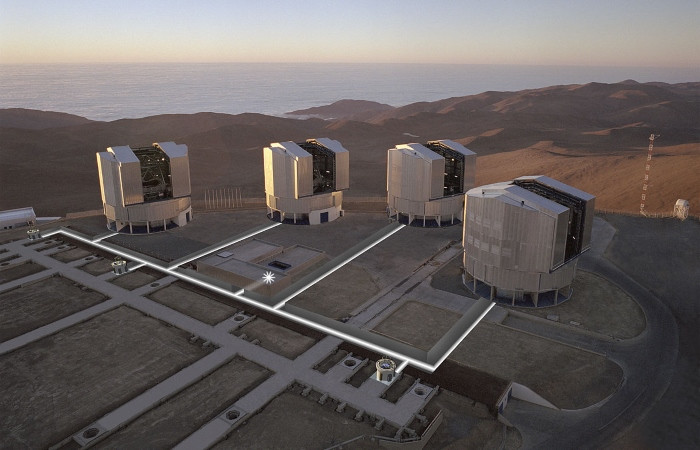Very Large Telescope: The pure eyes of humanity look at the universe
Located in the Atacama Desert in Chile, the largest telescope system of the Southern European Observatory (ESO) is so sensitive that a light emitted from the Moon can be seen.
The Very Large Telescope (VLT) was built in the Paranal Observatory area in the Atacama desert, northern Chile. This is a telescope system with 4 large glass with glass mirror diameter of 8.2 meters and 4 extra glass with smaller size.
Only one of the four glasses was able to see the object blurry 4 billion times more than the dimmer limit that the naked eye could observe. Excluding space telescopes flying in Earth orbit, this is the most advanced telescope system in the world.

The Milky Way in the southern hemisphere is crossing the sky above the Very Large Telescope (VLT) of the South European Observatory at the Atacama Desert in Chile.(Photo: Miguel Claro).
The first glass in the glass system called UT1 , "opened its eyes" and received the first light on May 25, 1998 and went into official operation on April 1, 1999. UT2 began observing just four days before the founding of the telescope system, March 5, 1999.
The four main glasses are placed in four domed buildings. These buildings have a cylindrical design and can rotate their axes. Not only are they built to protect the glass from environmental factors, but these buildings are also equipped with systems to help avoid interference for observations.
In addition to the four main glasses, the VLT has four auxiliary telescopes with a glass mirror diameter of 1.8 meters. All 8 telescopes are currently working together. Together, 8 telescopes will create a larger telescope with a wide viewing angle. However, they are often used alone to observe more celestial bodies.

With four main glass and four auxiliary glasses, all observing glass of VLT together will create a very large observation angle and become the largest optical observation device of humankind.(Photo: ESO).
Scientific studies
For nearly two decades, VLT has made significant contributions to astronomy. This glass system captured the first image of an exoplanet (planet outside the Solar System), made direct measurements of the atmosphere of an Earth-like exoplanet, measuring the temperature of Space,.
In 2004, a group of astronomers from Europe and the United States used VLT to observe the group of TW Hydrae objects, a group of small stars and other nearby objects. After the time of observation and research, the team learned that an Earth-like exoplanet orbiting a parent star like the Sun was 55 times greater than the distance from the Sun to Earth, This planet is 100 times more faint than its host star.
'This observation captures a planet, the first image taken of a planet outside the Solar System. This is a big step in both research, observation and photography of celestial bodies , 'said astronomer Gael Chauvin of ESO.

Beta Pictoris is a group of mysterious celestial bodies that have led scientists to suffer for years.Thanks to VLT, they discovered this is a planet with strange points.(Photo: SolStation).
In 2008, an international research team used VLT to explore and photograph an unknown body near the Beta Pictoris star . Finally, scientists learned that it was an alien planet, but the point is that the planet is too close to the host star, causing light from the star to drown out the faint light of the planet, making it important observation and detection become very difficult.
'Observing the extrasolar planets and knowing the distance from them to the host star is very important, which helps us to know the model of planetary systems in the universe and their development. Why, is it similar to the Solar System? But these observations are just the beginning.
We are only observing young giants now, in the future we will try to observe older, fainter and less hot stars. It's a challenge for the VLT and hopefully the next generation of telescopes will do this, ' said researcher Daniel Rouan.
Private company Breakthrough Initiatives has also been able to use the VLT to look at extraterrestrial planets around Proxima Centauri star, the star closest to the Sun. The company has partnered with a Russian billionaire and the late Stephen Hawking scientist in finding ways to quickly move to the planet.
Determine the planet's rotation speed
Scientists also used VLT to determine the rotation speed of the planet Beta Pictoris b, an important step by determining the speed of rotation of a planet far away and sunk in the light of the throne. Why is master difficult?
Researchers have determined the rotation speed of the planet's equator is 100,000 km / h, compared with 1,700 km / h in Earth and Jupiter is 47,000 km / hr. This is the speed of rotation of the highest axis ever recorded in a planet.
'We still don't know why the planetary rotation speed is so much different from each other. Although it has not yet measured many of the planet's extrinsic speeds, it is expected that the trend will remain the same as the solar system, that giant gas planets will spin faster than rocky planets with Small size , 'Remco de Kok said.
VLT is being upgraded to the spectrophotometer and imaging device with an infrared wavelength observation tool, which helps it to receive more light at more wavelengths from the stars, as well as to record components in their atmosphere. This upgrade is expected to be completed in 2019.
The discovery of the planetary system TRAPPIST-1 was an astronomical event in 2016, the VLT itself did this. This is the first planetary system with 7 planets discovered, 6 of them are rocky planets like Earth. All have the ability to survive liquid water on the surface.
'This is a great planetary system, not only because we find a planetary system with so many planets but because all of them are Earth-sized, conditioned , ' said the researcher. Michaël Gillon at the University of Liège, Belgium, said. After VLT discovered TRAPPIST-1, many other observatories around the world directed their lenses to the sky to study the planetary system further.

TRAPPIST-1 is one of the great discoveries of astronomy in 2016. VLT has discovered this planetary system with 7 planets, most of them have the ability to exist or support the development of life. .(Photo: ESO).
VLT is also used to survey the atmosphere of exoplanets. In 2010, this telescope system studied the outer planet GJ1214b similar to Earth but larger in size, and showed that the planet's climate is dominated by its dense atmosphere, gas layer. This volume also protects the planet from dangerous cosmic rays from outside.
In 2008, by detecting carbon monoxide molecules in a galaxy 11 billion light-years away, VLT measured the temperature of the universe, allowing scientists to know the temperature of the universe from very soon after it is formed.
VLT does a lot of scientific research. On average every day, a research paper published in newspapers or scientific journals is conducted by VLT observations. This is indeed the best eyes of humanity in the era of the universe.
- Large telescope construction to study the origin of the universe
- NASA is developing a telescope capable of saving humanity
- Microscope and telescope, which is more
- The most terrible telescope starts
- The telescope finds out the first moment of the universe
- China will build the second giant telescope to find aliens
- How to train pure eyes
- Turn on 'green light' for the world's largest telescope project
- The telescope has lobster eyes
- NASA builds the world's most powerful telescope
- Hubble's 'eyes' into the museum
- Eyes glow in the universe
 Norway built the world's tallest wooden tower
Norway built the world's tallest wooden tower Kremlin
Kremlin Ashurbanipal: The oldest royal library in the world
Ashurbanipal: The oldest royal library in the world Decoding the thousand-year construction of Qin Shihuang shocked the world
Decoding the thousand-year construction of Qin Shihuang shocked the world